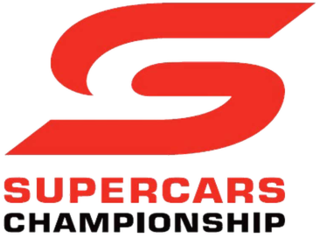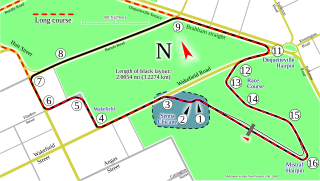
The Supercars Championship is a touring car racing category in Australia, running as an International Series under Fédération Internationale de l'Automobile (FIA) regulations, governing the sport.

The Bathurst 1000 is a 1,000-kilometre (621.4 mi) touring car race held annually on the Mount Panorama Circuit in Bathurst, New South Wales, Australia. It is currently run as part of the Supercars Championship, the most recent incarnation of the Australian Touring Car Championship. In 1987 it was a round of the World Touring Car Championship.

The Adelaide 500 is an annual motor racing event for Supercars. Held on the streets of the east end of Adelaide, South Australia between 1999 to 2020, and again in 2022. It is well known for sponsorship reasons as the Clipsal 500. The event uses a shortened form of the Adelaide Street Circuit, the former Australian Grand Prix track.

The Sandown 500 was an annual endurance motor race which was staged at the Sandown Raceway, near Melbourne, Victoria, Australia from 1964 to 2019. The event's name, distance – and the category of cars competing in it – has varied widely throughout its history. Most recently, the event was held as a championship event for Supercars from 2003 to 2007 and from 2012 to 2019.
The 2001 Shell Championship Series was an auto racing series for V8 Supercars. The championship, which was the third Shell Championship Series, began on 25 March 2001 at Phillip Island and ended on 2 December at Sandown after 13 rounds. The same events also determined the winner of the 2001 Australian Touring Car Championship as awarded by the Confederation of Australian Motor Sport.
Anthony Lawrence Longhurst is an Australian racing driver and former Australian Champion water skier. He is most noted for his career in the Australian Touring Car Championship and V8 Supercar series. Longhurst is a two-time winner of the Bathurst 1000, winning the event in 1988 with Tomas Mezera and in 2001 with Mark Skaife, and is one of only five drivers to win Bathurst in both a Ford and a Holden.

The Perth SuperNight is an annual motor racing event for Supercars, held at Wanneroo Raceway in Wanneroo, Western Australia. The event has been a regular part of the Supercars Championship and its predecessor, the Australian Touring Car Championship, since 1973.

The 2005 Super Cheap Auto 1000 was an endurance motor race for V8 Supercars. The race was held on 9 October 2005 at the Mount Panorama Circuit just outside Bathurst in New South Wales, Australia and was Round 10 of the 2005 V8 Supercar Championship Series. It was the ninth running of the Australia 1000 race, first held after the organisational split over the Bathurst 1000 that occurred in 1997. It was the 48th in a sequence of endurance races which commenced with the 1960 Armstrong 500 held at Phillip Island and 2005 was the 43rd year in which these races had been run at the Mount Panorama Circuit. It was also the first to be run under new naming rights sponsor, Australian automotive retail chain Super Cheap Auto.

The eighth round of the V8 Supercar Championship was held at Winton Motor Raceway in Benalla, Victoria, on the weekend of August 1 to August 3 of 2008.

The 2008 L&H 500 was the ninth round of the 2008 V8 Supercar Championship Series. It was held on the weekend of the 12 to 14 September at Phillip Island Grand Prix Circuit in Victoria. It was the eighth Phillip Island 500 and the first to be staged since 1977. The L&H 500 saw the Phillip Island Grand Prix Circuit replace Sandown Raceway as the venue of the annual 500 kilometre two-driver V8 Supercar race. In an innovation for this round, two preliminary 14 lap races were held on Saturday with the two drivers of each car starting one race each. A single pitstop by each car in either race was mandated with the combined results of the two races determining the grid for the main 500 kilometre event.

The Canberra Street Circuit was a temporary street circuit located in Canberra, Australian Capital Territory, Australia. It hosted the Canberra 400 for the V8 Supercars series from 2000 to 2002.

The 2009 Hamilton 400 was the second race meeting of the 2009 V8 Supercar Championship Series. It was held on the weekend of 17–19 April around the inner city streets of Hamilton, in New Zealand. The 2009 Hamilton 400 was the second running of the event.

The 2009 L&H 500 was the Race 17 of the 2009 V8 Supercar Championship Series. It was held on the weekend of 11 to 13 September at the Phillip Island Grand Prix Circuit in Victoria, Australia. This was the ninth running of the Phillip Island 500 and the second time that Phillip Island had served as the venue for the annual 500 kilometre two-driver V8 Supercar endurance race. Unique to this event, two preliminary 14 lap Qualifying Races were held on Saturday with the two drivers of each car starting one race each. A single pitstop by each car in either race was mandated with the combined results of the two races determining the grid for the main 500 kilometre race. The three races all carried championship points and together constituted "Race 17" of the championship. However the finishing positions at the end of the 500 km race were deemed to be the finishing positions of the "2009 L&H 500" regardless of the total points scored by drivers over the three individual races.

The 2010 Yas V8 400 was a motor race for the Australian sedan-based V8 Supercars. It was the first race of the 2010 V8 Supercar Championship Series. It was held on the weekend of February 18–20 on Yas Marina Circuit, in Abu Dhabi, United Arab Emirates. It was the first time V8 Supercar visited the circuit and only the fourth time V8 Supercar had visited the Middle-East, having three times previously raced at the Bahrain International Circuit. The two Asian venues were linked together for the 2010 season, causing the cancellation of the 2009 Desert 400 at Bahrain, and the 2010 Desert 400 will take place the week following the Yas V8 400.

The 2010 L&H 500 was the ninth event of the 2010 V8 Supercar Championship Series. It was held on the weekend of 10 to 12 September at the Phillip Island Grand Prix Circuit in Victoria, Australia. The 2010 event was the tenth running of the Phillip Island 500 and it marked the third time that the Phillip Island circuit had served as the venue for the annual 500 kilometre two-driver V8 Supercar race. The event consisted of two Qualifying sessions, two Qualifying Races and a 500 kilometre race which was Race 17 of the Championship. The two drivers nominated for each car contested separate qualifying sessions and, unique to this event, two preliminary 14 lap Qualifying Races were held on Saturday with the two drivers of each car starting one race each. A single pitstop by each car in either race was mandated with the combined results of the two races determining the grid order for the main 500 kilometre race. Championship points were awarded for each of the three races, however the finishing positions of the "L & H 500" were determined by the finishing positions at the end of Race 17, regardless of the total number of points accumulated by any driver pairing at the event.

The 2011 L&H 500 was the ninth event of the 2011 International V8 Supercars Championship. It was held on the weekend of 16 to 18 September at the Phillip Island Grand Prix Circuit in Victoria, Australia. This was the eleventh running of the Phillip Island 500, the fourth occasion in which it filled the role of the annual 500 kilometre, two-driver V8 Supercar race, and the 21st ATCC championship race meeting at the circuit. It was also the last 500 kilometre race for V8 Supercars at Phillip Island, as the endurance race returned to Sandown Raceway in 2012, and the Phillip Island event reverted to a sprint race format with two 150 kilometre races.

The Phillip Island SuperSprint was an annual motor racing event for Supercars, held at the Phillip Island Grand Prix Circuit in Phillip Island, Victoria. The event was a semi-regular part of the Supercars Championship, and its previous incarnations, the Australian Touring Car Championship, Shell Championship Series and V8 Supercars Championship, between 1990 and 2019.

The Sydney SuperNight is an annual motor racing event for Supercars, held at Sydney Motorsport Park in Eastern Creek, New South Wales. The event has been a semi-regular part of the Supercars Championship—and its previous incarnations, the Australian Touring Car Championship, Shell Championship Series and V8 Supercars Championship—since 1992. Since 2018, this is the only active Supercars event held in metropolitan Sydney.

The Supercars Challenge was an annual non-championship motor racing event held for cars from the Supercars Championship, and formerly from V8 Supercars, the Shell Championship Series and the Australian Touring Car Championship. The event is held on the Albert Park Circuit in Albert Park, Victoria, Australia as a support event to the Australian Grand Prix.

The 2019 Melbourne 400 was a motor racing event for the Supercars Championship held as a support event to the 2019 Australian Grand Prix from 14 March to 17 March 2019. It was held at the Melbourne Grand Prix Circuit and consisted of two races of 70 kilometres and two races of 130 kilometres. It was the second event of fifteen in the 2019 Supercars Championship and the second running of the Melbourne 400 event.












